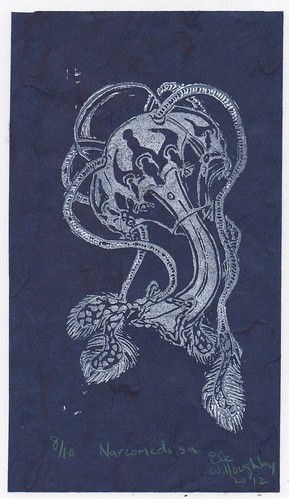
I made this dainty lino block print of a Narcomedusae order of jellyfish on beautiful handmade deep blue Japanese Chitose Gunjo paper with silk fibres which add to the organic feel of the piece and makes each print rather unique. Each print in this edition of 10, is 4.5 inches by 8 inches or 11.3 cm by 20.3 cm.
Jellyfish have such beautiful, fluid, organic lines. This seems to mirror the view of Ernst Haekel, the famed German biologist, naturalist, philosopher, physician, professor and artist (and influence on me), whose book "Art Forms in Nature" filled with lovely 19th century scientific illustrations of biology inspired my original drawing and then carving in linoleum of this creature. In fact, Haekel himself named this order of animals in 1879.
I've been wondering about their name. The discomedusa sounds like a medusa (as in jellyfish, rather than Μέδουσα the snake-headed Gorgon of Greek myth) boogieing on the dance floor, but of course, the "disco-" refers to its disk-like shape. "Narco-" means "numbness or torpor" rather than indicating that this jellyfish is somehow involved in the drug trade. Now, I don't know if these jellies are numb or torpid, or whether they sting (something which often leads to numbness). Haeckel's other medusas are the tracho- or tranchymedusa ("rough" medusa), leptomedusa ("thin, fine or slight" medusa), peromedusa ("malformed" medusa, ouch!), anthomedusa ("flower" medusa), stauromedusa ("cross", as in the shape rather than the mood, medusa), and cubomedusa (which are the box jellyfish). So now you know.









No comments:
Post a Comment